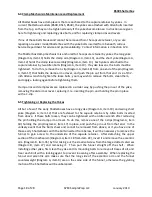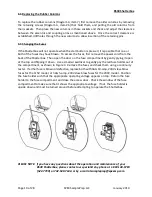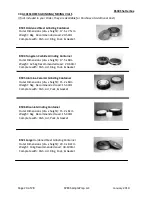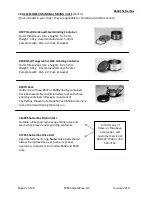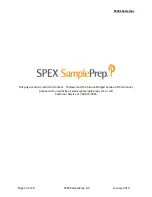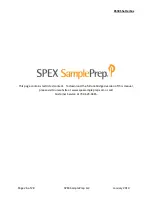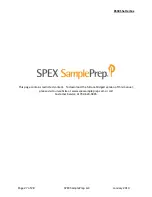
8530 Shatterbox
Page 13 of 28
SPEX SamplePrep LLC January 2010
5.1 Grinding Containers
There are at present ten different Shatterbox grinding containers in five different materials and
four sizes; while each of the ten has a puck-shaped grinding element or a puck and ring, each
has different requirements for sample size and/or grinding time. Consequently the following
instructions are general in nature.
5.1.1
Choice of Grinding-Container Material
Every grinding-container material has its benefits and drawbacks. Some will contaminate a
sample fairly heavily, others lightly; some will grind a sample more rapidly than others, while
some are more prone to breakage; and there are cost considerations. Detailed advice on
choosing the proper grinding container can be found in the
Handbook of Sample Preparation
and Handling
.
Often the prime consideration in choosing the container material is whether it will contaminate
the sample with elements of interest in the analysis. Thus steel mills looking for iron in slag will
choose tungsten carbide over steel, while a geochemist doing trace-element determinations in
igneous rocks might avoid both zirconia ceramic for its major Zr and Hf, and tungsten carbide
for the small amounts of Ti, Ta, and Nb present.
Performance is also important: the denser the grinding-container material, the more rapid the
grinding. Tungsten carbide is the densest, followed by steel, zirconia ceramic, and alumina
ceramic. Of these, steel is the most prone to wear if the samples are hard; however, it is the
only material of the four warranted against breakage. The following summary of properties
may be helpful:
Steel:
is extraordinarily durable and relatively inexpensive, but subject to unusual wear when
used to grind hard materials (quartz and feldspar, glasses and slag). Grinds rapidly but tends to
contaminate. Major element: Fe. Minor elements: Cr, C, Mn, and Si.
Tungsten Carbide:
grinds very rapidly and wears well, but is subject to occasional breakage. It
is harder than most samples other than the hardest refractories, but contaminates moderately.
Major elements: W, C, Co. Minor elements: Ta, Ti, and Nb.
Zirconia Ceramic:
is harder than steel and most slag and mineral samples, but is neither as
heavy nor as hard as tungsten carbide. Grinds fairly rapidly with low contamination levels, and
almost never breaks. Major elements: Zr. Minor elements: Hf, Mg.
Alumina Ceramic:
is harder than tungsten carbide, but is comparatively lightweight. It grinds
fairly slowly with low contamination levels and is subject to fracture. Major elements: Al.
Minor elements: Si, Mg, and Ca.


















